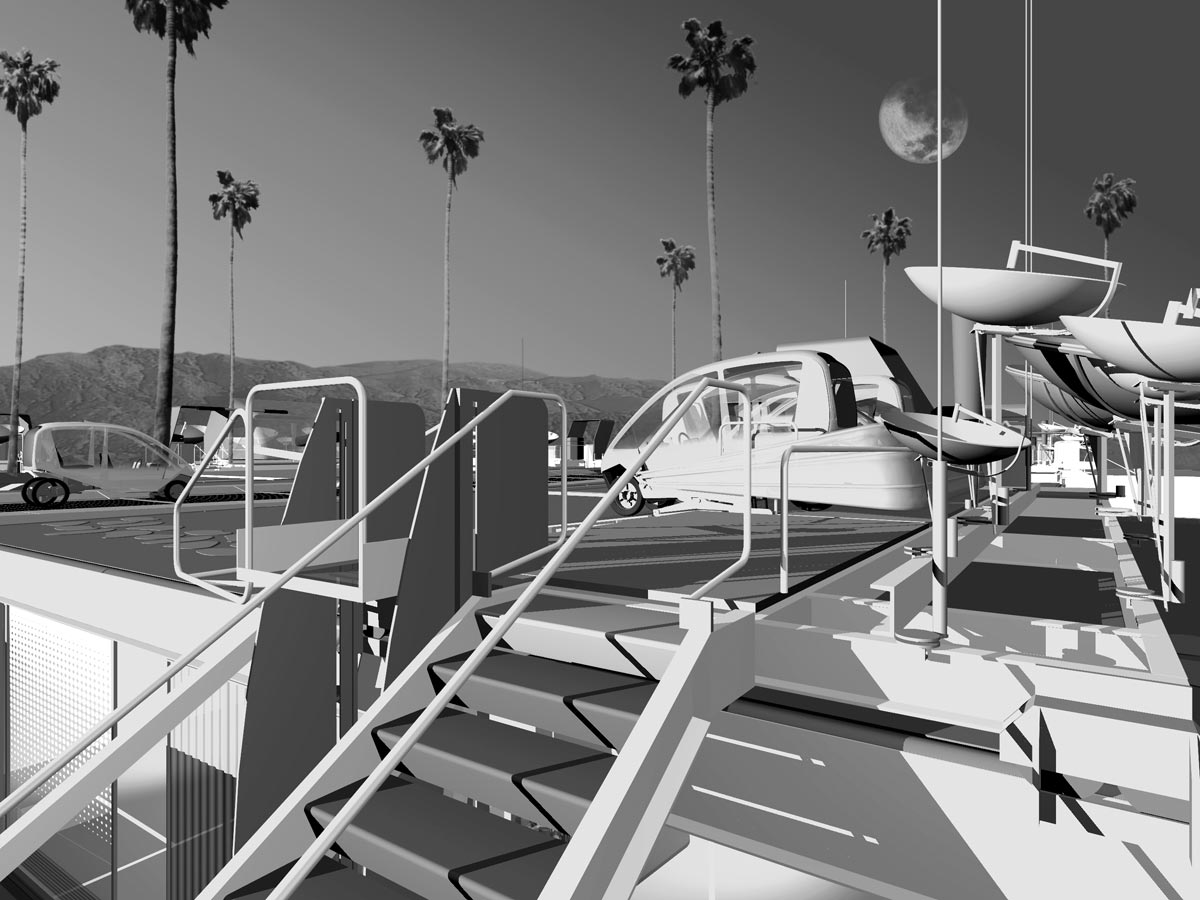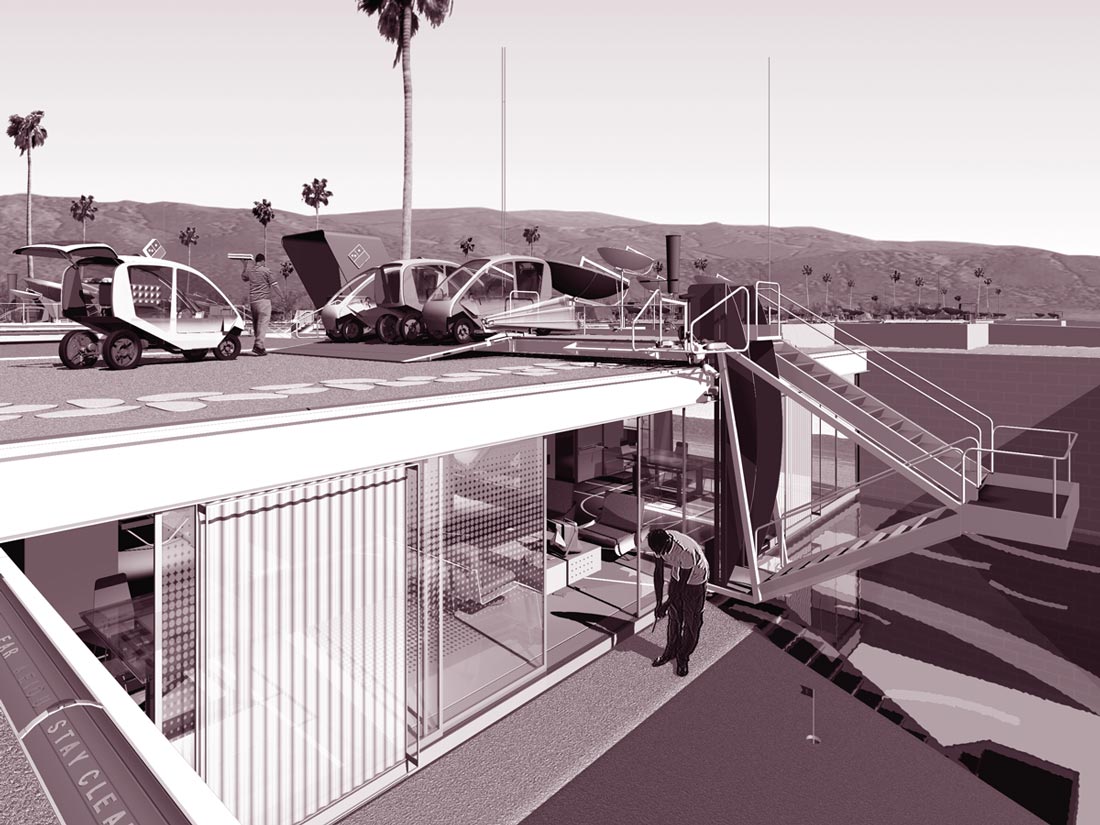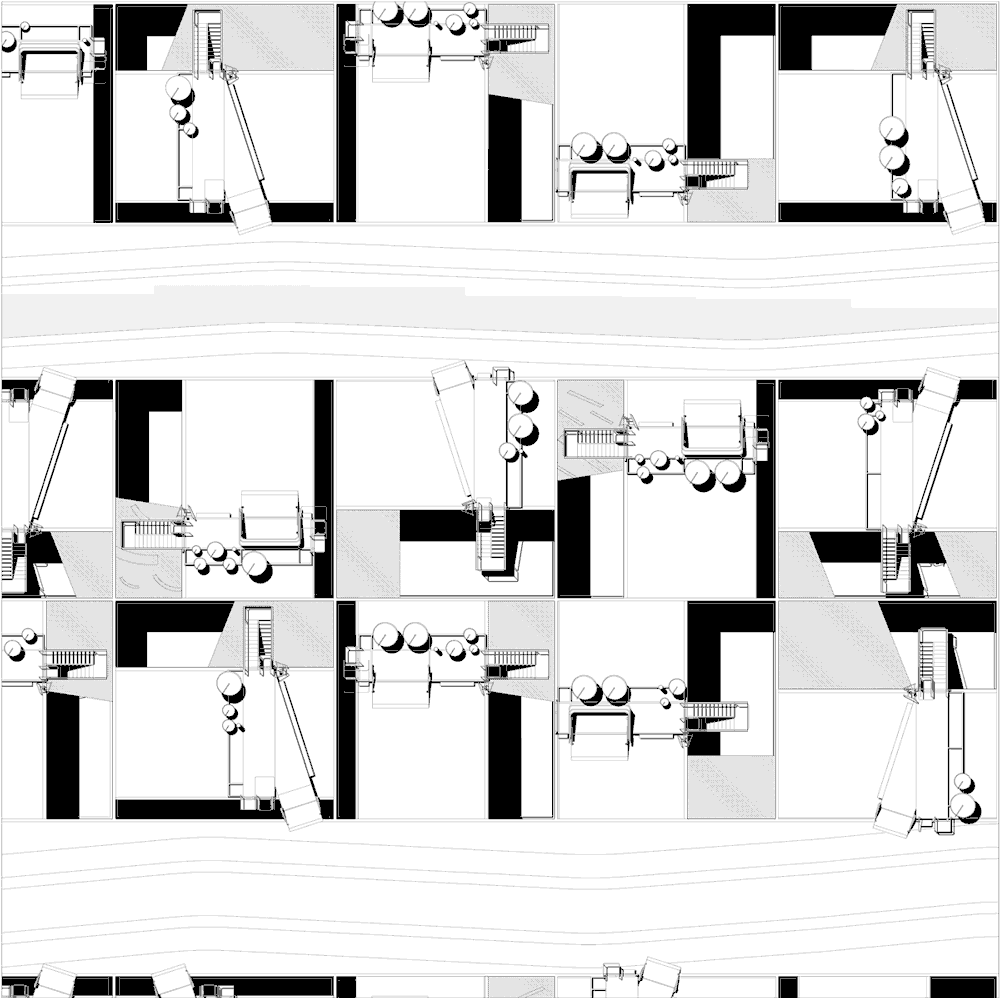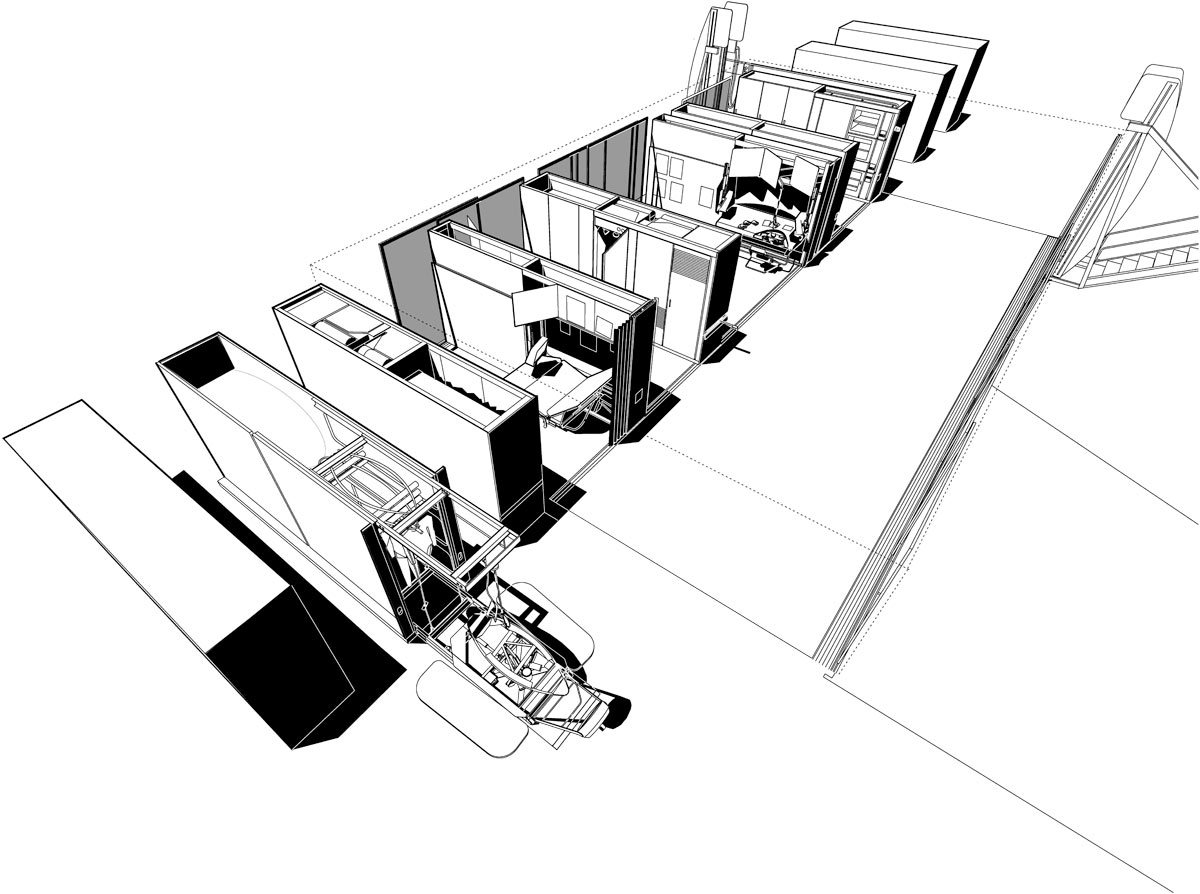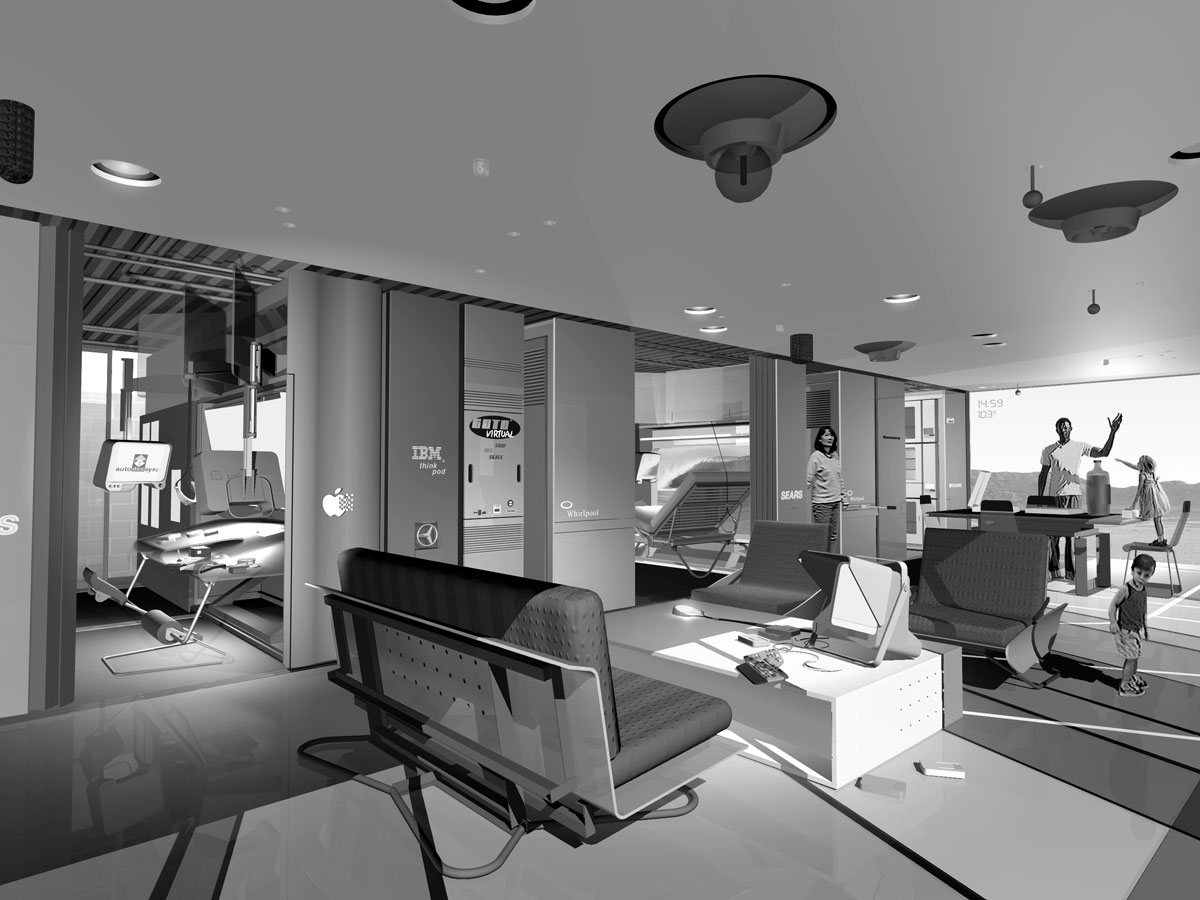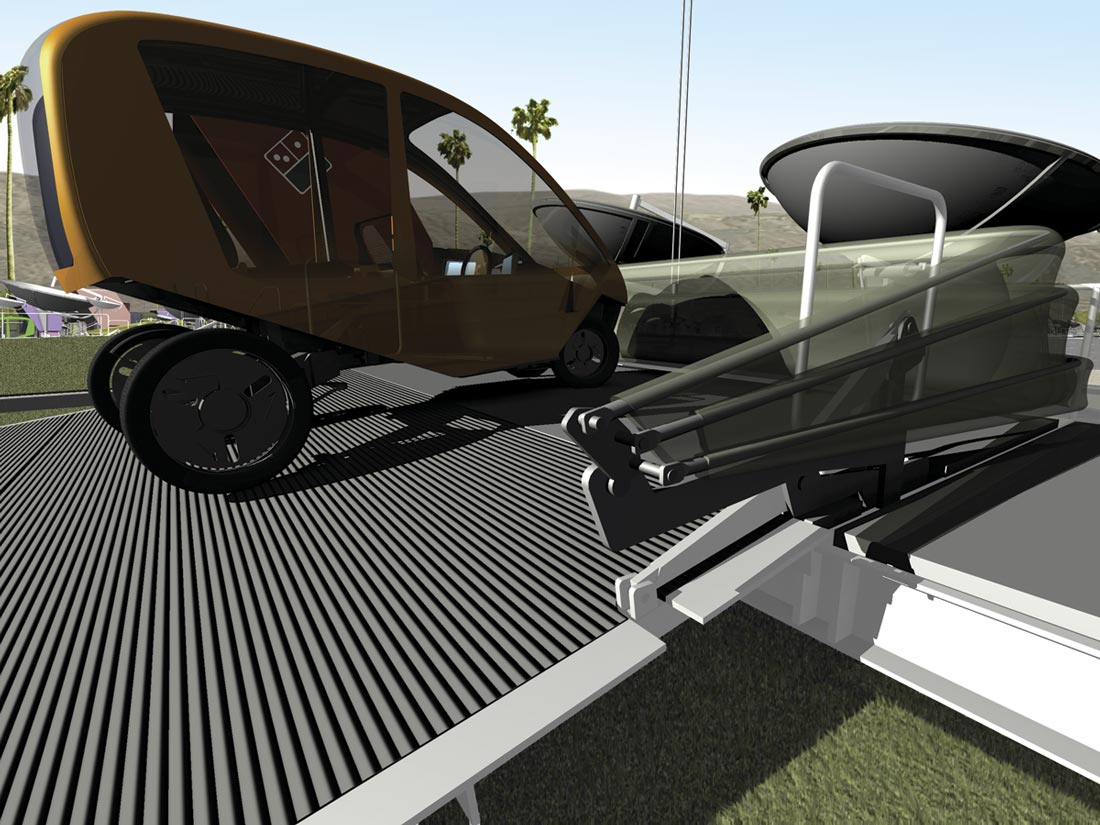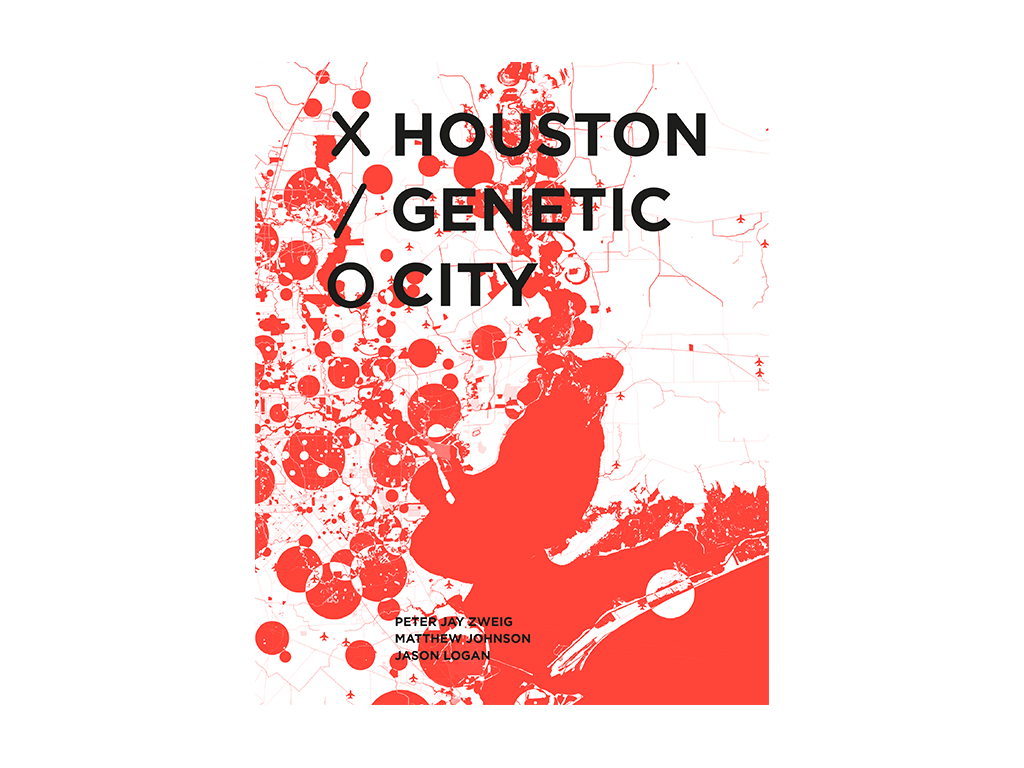From the time magazine article: “If history is any guide, the future is not really likely to be that different from now”: a look backward twenty-five years now, in the future of the seventies, shows little that is startlingly new—particularly in the built environment. What can be noticed is how much bigger and more elaborate (not to mention more predominantly Mediterranean™), the suburban house is today, and how much smaller the lot. Both are probably responses to the home’s new role as a short-term investment (rather than a place to put down roots), and the real estate industry’s corresponding scramble to come up with more list-able (countable) amenities.
Substantive changes are lurking on the horizon, though. It is no surprise that the computer revolution will bring the most telling of these. After all, the consummation of the cyber revolution will affect what is considered reality, introducing a new, but increasingly less alternative, universe of work and play. More surprising might be the triumph of the green revolution, following the eco-conscious boomer’s achievement of geriatric legislative might, and their children’s growth to adulthood as the first generation of habitual recyclers. While the computer will promote a dramatic trend towards decentralization, allowing people to spread out and live or work anywhere, the green consciousness will urge a contrasting densification in order to conserve resources and open space. The reconciliation of these opposed trajectories will define the sub-‘burb of the future.
This will occur as the consuming vastness of cyberspace satisfies the historic suburban craving for more space, allowing the house to shrink to a more supportable size (the yard has already shrunk beyond what the name can support, in the interests of the pocket mansion’s hunger for more interior space). The wasteful “setbacks” between neighbors will be eliminated when privacy becomes more of a virtual concern, helping to cut down on sprawl. Cyberspace will even provide a less damaging arena for the demonstration of conspicuous consumption, inheriting the responsibility for status-display from the house and front lawn. With cyberspace taking care of the private realm, the physical world will be freed for more generous community gestures. The park-like ideal will be clearer when the cheek-by-jowl pocket-mansion planning typical of developments today no longer mars the suburban landscape—and signs of individual affluence no longer signify community poverty.
The trends toward decentralization promoted by the cyber revolution will have obvious social effects, and these will also impact the physical environment. In particular, the computer will challenge the cohesiveness of the family—the standard suburban unit of measure—as each of its members become self-sufficient citizens of an alternative world increasingly seen as the one that matters. Within this new virtual world kids will grow up much more quickly, un-restrained by any biological clock or accident of personal appearance. Even the youngest cyber-savvy family member might be employed, for example. This will translate into a greater independence for the children in the physical world as well, since their cyber sophistication will make them confident with atms, fast food automats, and dial-a-ride shuttles, while their security, communication and medical “patches” and implants will make them safer “out there” than today’s kids. Parents will relax their vigilance—freeing up psychological space for other pursuits. As the family thus becomes diffuse, the home will respond with a contrasting cohesiveness. As cyber space becomes the kind of space that matters, the primitive sense of territorial “ownership” will fade within the house as it has within the neighborhood, and the house program will be more finely divided among specific activities rather than among family members.
Genetic engineering will play a role as well, offering biological solutions to problems once thought to be strictly mechanical, primarily by reducing the impact of all these people on the land through new waste-treatment technologies.
This “Sub-‘burb” responds to the economic pressures on the limited landscape to increase density and to the related need to maintain the unique suburban balance between privacy and display despite such density; it answers the necessity for greater ecological responsibility, and takes account of the reorientation towards spatial reality prompted by the increasing importance of the computer and cyberworld.
The Sub-‘burb proposes a continuous carpet of habitation that is approximately twice as dense as the existing suburban model, but which confines all the building below the circulation datum, so that the park-like nature of the garden city ideal is emphasized at the public level. The openness of this field of lawns is preserved through the use of air-bag guardrails, which provide fall protection only when needed. The status display function of suburbia is satisfied on line and at the upper, public level, without bulking up the house, by separating the functions of dwelling and storage; since all the courtyard houses are out of sight, status is conveyed by the quality of stuff rather than the size of the house, and these possessions—cars (e.l.o.v.), satellite data services, meal services, etc—are arranged on a mobile platform for the neighbor’s inspection.
The infrastructure for the tract lies in the space below the roads, and includes energy, sewer, water, and data, along with access tunnels. Also located under the roadbed proper is a rockbed thermal storage area which supplies ceiling and floor plenums in the adjacent houses with conditioned air, heated or cooled according to the season. The increased density allows for the provision of a neighborhood-sized strip of open space at the public level for each group of forty houses.
Below the public level, the courtyard for each residence provides complete privacy, efficiently accessing just the right amount of outdoors and nature necessary to promote a sense of well-being, without intruding into the neighbor’s perceptual field or sprawling beyond its needs. Each courtyard is designed to provide for microclimate adjustment, using a balance of plantings and a pond area to promote the evaporative cooling and humidification so crucial to comfort in a desert setting.
Access to each house is gained through this courtyard, entered from above by a stair and lift device appended to the mobile display platform. This device can be pedaled from one end of the lot to the other, providing the resident with exercise as well as mowing the lawn, mulching the trimmings, and supplying additional power to the household batteries. Inside, the house is organized to provide all the program of a typical 3 bedroom suburban house in less than half the space, through the use of a mobile program deck (PRO/dek: US pat. 6,526,702B2). The area of the house is divided in half longitudinally into zones of greater or lesser programmatic control; one half is taken up by the shuttling pods of the program deck while the other half is left open as free space. The PRO/dek takes advantage of the fact that in the typical dwelling only a few of the rooms are ever being used simultaneously, and so eliminates that space of the unused rooms, or rather trades it for additional unprogrammed free space. This additional area serves as the family’s political space, where the individual members must negotiate its disposition at any particular time.
Without the need to stand alone as a castle on its own piece of the frontier, the sub-‘burban house of the future will combine with its neighbors in more space-efficient patterns. The resulting “courtyard” environment will enjoy a greater sense of privacy from its immediate neighbors—without resorting to hostile fences or walls—and the view across the neighborhood will be completely open, except for the dish farms, elovs and delivery terminals screened by shrubs.
While the individual house will not be completely off the grid by 2025, its energy needs will be greatly reduced. A variety of passive measures, including more sophisticated insulation strategies, rock bed thermal storage under the adjacent roads, and adjustment of the microclimate with liquid crystal shading, thermal mass and cooling ponds, will reduce the houses’ energy consumption to the point where its residual requirements will be met by a small, highly efficient neighborhood power station. Because of the density of the tract, only minor line losses will be experienced. Next generation photovoltaics embedded in the road system and intertwined with the passive heat absorption media will supplement this decentralized power distribution with diffuse direct feed.
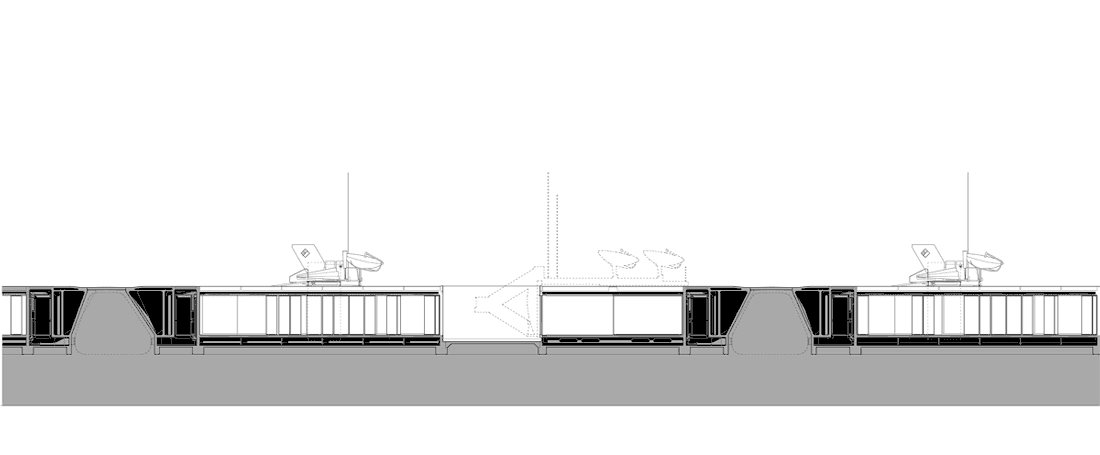 The power requirements for moving household elements, like the dish-farm/lawnmower/delivery service/elov storage unit above or the PRO/dek units inside, will be supplied by manual effort (as a sort of workout program), made feasible by advanced materials and a more sophisticated use of good ol’ nineteenth century gear and counterweight technology. This approach will not only save energy and provide exercise, but will engage the homeowner more directly in the physical environment—as a relief from the virtual realm where so much of life will otherwise be spent.
The power requirements for moving household elements, like the dish-farm/lawnmower/delivery service/elov storage unit above or the PRO/dek units inside, will be supplied by manual effort (as a sort of workout program), made feasible by advanced materials and a more sophisticated use of good ol’ nineteenth century gear and counterweight technology. This approach will not only save energy and provide exercise, but will engage the homeowner more directly in the physical environment—as a relief from the virtual realm where so much of life will otherwise be spent.
Eventually, the codependent excesses of the insurance and litigation industries will cause most of the nation’s monuments to be closed to the public or extensively fortified. Two innovations will solve this problem and restore a sense of freedom to the physical environment: the stair climbing wheelchair, and the vowel-, or Automatic-Explosive-Inflation, Occasional-Use (AEIOU), guardrail that will evolve from the present day auto air bag.
It takes no imagination to predict that the walls of the house of the future will be active display surfaces, providing a virtual window to anywhere. Since the decorative needs of any environment will be satisfied by such displays, architecture itself will become more neutral, more “blank.” A Miesian simplicity and utilitarian honesty will come to dominate physical design, both because the virtual has usurped architecture’s expressive role and because the physical will come to be valued for its contrast with the trickery of the virtual.
In contrast to an increasingly labyrinthine cyberspace, the house will be organized simply. There will be no individual rooms; instead, a zone serving the family’s functional needs will share the single large space with an open area, serving its social needs. The function zone will be occupied by a movable “program deck” of activity pods, sold as major appliances, that serve these functions: together they will form a household system evolved from the high-density shelving systems used today for volume document storage. Thus, instead of dedicating a seldom-occupied room to each function, hobby or household activity, these “rooms” will appear only on an “as needed” basis, and be stowed away when not in use to make space for those that are. In this way the equivalent of a four bedroom, three bath house can be fit into the area presently taken up by a small two bedroom apartment.
In explicit contrast to the more individual-oriented appliance zone, the social space, or family-as-community space, will be more open. Redefined continuously through the conscious, (political) interactions of the family members, it will be the non-virtual agora for the post-nuclear family’s FTF encounters.
Few will choose to work with the wall displays that have become the default interface, preferring the more immersive experience of the virtual workstation. In fact, a sense will develop that unless you are in the environment, “where” you can feel the flow of information, you are somehow missing something. And so the serious worker will leave the wall displays for background entertainment, like the ambient music of the late twentieth century.
In the future, few families will cook. The perfected technology of food delivery will make subscriber-based, nutritionally-guaranteed, “home meal replacement” systems a huge industry. The “kitchen” will become more of a butler’s pantry, where the prepared food is un-packaged, zapped and readied for the table. There will still be a supermarket for those who insist on continuing to “cook” for themselves, but it will only be accessed virtually, and its products will be delivered by the same system. Such “cookers” will be regarded, like vegetarians, with affectionate bemusement by the rest of the population.
All waste will be dealt with by a genetically engineered strain of soil eating microbes, entirely on-site—there will no longer be sewers or treatment plants for household waste. Though the microbes could do the job directly in the toilet or clothes hamper, it will be handled out of sight for aesthetic reasons, in an adjacent, fixture-dedicated septic tank or waterless “washing machine,” part of a fully closed waste management cycle. The unregenerate bits will be composted and spread to the overhead lawn during the mowing pass of the dish-farm/lawnmower/delivery service/elov storage platform. Additionally, microbes will patrol the other functional units of the bath-room appliance, like the lavatory or shower units, scouring their surfaces of all odor causing germs.
The bedroom appliance will combine a “murphy”-type folding adjustable bed with a closet space and personal VR equipment. Because cyberspace will have become the preferred arena for personal display and entertainment, personal effects storage needs will be greatly reduced. Few people will own more than a few sets of activity-specific, fashion-neutral clothes, and everything else will fit onto teradex, at least until the new googol-shred comes out.
In the future, the family’s conspicuous consumption of recreational equipment—the ski-doos, off-road vehicles, snowmobiles, speedboats, or Winnebagos that adorn today’s driveway—will be replaced by an equal number of gaming pods and recreational simulators. Like today’s family with more dirt bikes than dirt, the future sub-‘burbians will crowd themselves out of their even more limited space with their hoard of Virtual Skiing and Simulated Surfing units.
The ceiling will be populated with surveillance blisters and related instrumentation, including simple video-conferencing devices, medical and security scanners, and environmental registers, as well as active lights and hvac diffusers and sensors.
A note on the car of the future: California will lead the way to a new kind of vehicle when its traffic and environmental problems collide. The futility of the mass transit and carpooling Band-Aids, which conflict with the American ideal of individual freedom of locomotion, will be recognized, and a fully electric low occupancy vehicle (“elov”) will be developed. These vehicles will be light weight (few metallic parts), less than half as wide as present day cars, and far safer. The weight reduction and propulsion system will make them pollution free; their size will mean that the number of lanes on the freeway will be doubled and the freeway system’s capacity quadrupled, and their technical sophistication (active suspension and power train) will mean that despite their proportions they will be far more stable than today’s SUV’s so they will be less likely to lose control—but when they do, their materiality (light weight) will mean that in accidents they will most likely just bounce off each other. Stability will be provided by an active suspension system, with each wheel powered independently by its own digitally controlled micromotor. The family vehicle will be created by joining the elov’s together side to side: they will lock at the inside wheels, which the suspension will raise off the road, and the inside door will slide away to make a single continuous interior compartment. These family-sized wide loads will have special lanes on the freeways and larger city streets, but would otherwise be unrestricted.

